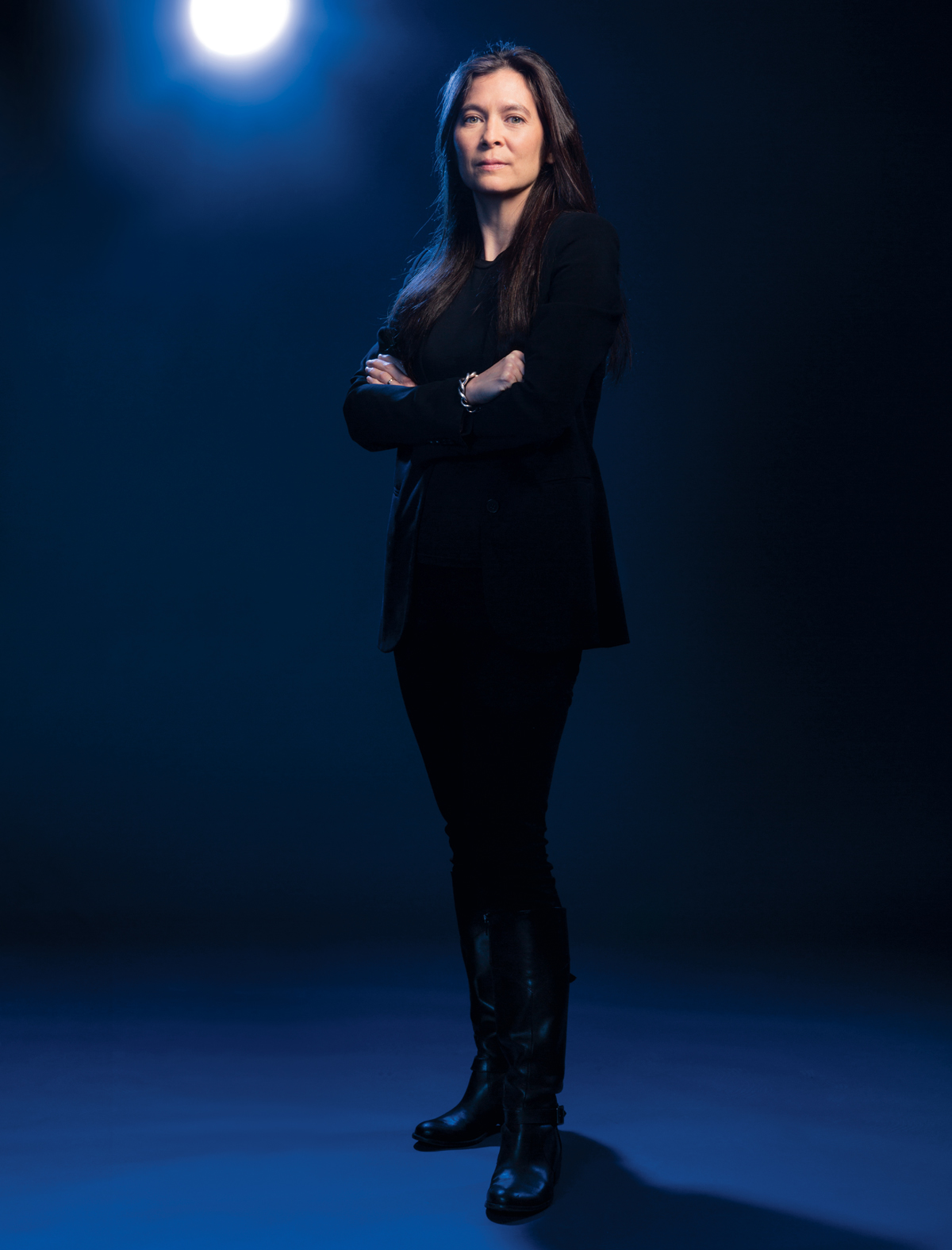Diane Paulus: Drama Queen

Diane Paulus enjoys a moment in the spotlight. (Photograph by Jason Grow. Hair and makeup by Maryelle O’Rourke/Team.)
Diane Paulus’s broadway version of Pippin opens in near darkness. As the audience waits in anticipation, a mysterious figure, lit from behind, creeps downstage behind a circus tent. The woman’s shadow grows smaller and smaller until, suddenly, she bursts through a crack in the fabric with hips snapping and teeth gleaming: a cat-suited vamp who will work the crowd over from the edge of the stage. Moments later the curtain falls away to reveal a riot of acrobats and circus artists. Jugglers, contortionists, aerialists, hand walkers, and tumblers perform their stunts in a lush choreographed chaos of color and movement.
This is the theatrical equivalent of starting a party with champagne, noisemakers, and confetti. Think Dorothy stepping out of her farmhouse and into dazzling Technicolor Oz. Grandmothers gasp in their seats. Small children squeal. All of which signal a pacing no-no—except in Paulus’s hands, the party won’t stop.
Since she was named the artistic director of Cambridge’s American Repertory Theater six years ago, Paulus has brought ever-more-ravishing shows like this one to her audiences, and in so doing, has been hailed as the green thumb of American theater. “This is a Pippin for the 21st century,” said the New York Times theater critic Ben Brantley in his April 2013 review, “when it takes more than style to hold the attention of a restless, sensation-hungry audience.”
Paulus has also become Broadway’s darling. This past November, her revival of Pippin, which started at the ART and earned Paulus the 2013 Tony Award for Best Director of a Musical, was playing at the Music Box Theatre. The marquee on the Booth Theatre directly across the street advertised The Glass Menagerie, the ART revival starring Cherry Jones and Zachary Quinto that moved to Broadway following its premiere in Cambridge. A few doors down, Once, which also premiered at the ART, had been playing at the Bernard B. Jacobs Theatre for two years. Three blocks away, on the third floor of the Foxwoods Theatre, Paulus was rehearsing the national touring cast of The Gershwins’ Porgy and Bess, another production that began here and went on to Broadway.
As a director, Paulus is a study in dualities: a nostalgist and an innovator, a stylist and storyteller, an ardent team player and iron-fisted leader, and, most important, a Broadway baby and Harvard intellectual. Her ease in these last two seemingly contradictory arenas has enabled her to knock down the wall separating highbrow and lowbrow in the theater world, bolstering the ART’s bottom line by presenting adventurous work with mass appeal.
Yet some say that Paulus’s populist approach may have forsaken the ART to save it. For decades, Harvard’s theater was known as Boston’s venue for serious, avant-garde artistic expression—an elite arts organization at the country’s premier academic institution in a city that prides itself on heritage and tradition. Over the years, however, dwindling audiences put the theater in the red. Now that Paulus has made the ART a launching pad to Broadway, the organization is once again financially stable. But in the process of rescuing it, has she corrupted the art of experimental theater?
On a windy day in November, Paulus, 47, arrives at the Foxwoods Rehearsal Studios on 43rd Street at 10 a.m. wearing a belted tunic, slim trousers, and tall boots. Years of ballet training are evident in her lean physique, the straight set of her shoulders, and her turned-out feet. She wears no makeup and dresses in black, which makes her huge green eyes pop. She works incessantly, prolifically, and claims to be unburdened by self-doubt.
For the next three hours she rehearses the Porgy traveling company, alternately standing bolt upright with arms crossed and legs planted in a wide stance, and perched at the end of a metal folding chair murmuring a stream of notes to her assistant director, Harvard grad Mia Walker. They’re running Act 3, Scene 2. Sportin’ Life is trying to persuade Bess to leave Catfish Row and go to New York City with him, and Paulus feeds direction to Kingsley Leggs, the actor playing Sportin’ Life, in precisely syncopated beats between his lines. She’s right in his head, as a director should be. She’s also a coach, and an analyst, and a siren, loosing a mellifluous flow of enticements.
“You’re right in this argument.” “You are so right.” “Move in on that.” “There’s a boat leaving for New York.” “It’s the apple.” “That’s the carrot.” “That’s so cool.” The song begins, and after four bars Paulus stops the action and strides onto the stage, which is marked off with yellow tape. Even the actors who aren’t in the scene, who are milling about the edges of the room with aprons and fishing gear over their sweatpants and sneakers, snap to. All eyes are on their director.
Paulus in a rehearsal room is in the zone, in the same way other people are when they meditate or do yoga. “It’s freeing,” she says, “to not be caught up in your own personal baggage.” Suddenly she bursts into the song’s opening line in a brassy voice: “There’s…a…boat that’s leavin’ soon…for New York!” and as she sashays diagonally downstage she wonders out loud how to make this moment bigger and splashier. Half a dozen people pipe up with ideas: Leggs, choreographer Ronald Brown, music director Dale Rieling, associate director Nancy Harrington, and a couple of others with indeterminate jobs. Paulus listens, muses, has Leggs try out a few of the suggestions, and settles on a series of pointed leg kicks and crisp finger snaps. They run it. Leggs delivers, like a snake-oil salesman on a chorus line. Perfect. Paulus nods and lets the scene play out.
“You’ve got her,” Paulus says matter-of-factly and so quietly she may as well be talking to herself. “You’ve got her. That’s such a turn-on.”
Two and a half years ago, when Paulus unveiled her version of the beloved opera, it caused a very Pauluslike dustup—one in which her creative license again clashed with a sacred cow. Her adaptation includes additions and deletions, punched-up dialogue, and invented biographical details. Before it even opened it ruffled some feathers, including Stephen Sondheim’s. When he read about the changes Paulus was making (with the blessing of the Gershwin estate) in the New York Times, Sondheim wrote a scathing letter to the editor, which read in part:
Then there is Ms. Paulus’s condescension toward the audience. She says, “I’m sorry, but to ask an audience these days to invest three hours in a show requires your heroine be an understandable and fully rounded character.” I don’t know what she’s sorry about, but I’m glad she can speak for all of us restless theatergoers. If she doesn’t understand Bess and feels she has to “excavate” the show, she clearly thinks it’s a ruin, so why is she doing it? I’m sorry, but could the problem be her lack of understanding, not [Porgy author DuBose] Heyward’s?
Asked how Sondheim’s criticism affected her, Paulus responds with silence. She’s in a plane at Logan, waiting to take off, speaking to me via phone. Following numerous failed attempts over many weeks to complete an interview we’d started in her Cambridge office, we continue our conversation on the fly. She finally says in a low, measured voice, “It was a moment of incredible determination on the part of the cast to just put our heads down and focus on the work, and let the work speak for itself.” Then she adds, “I’m sorry that Stephen Sondheim never saw the production.”

